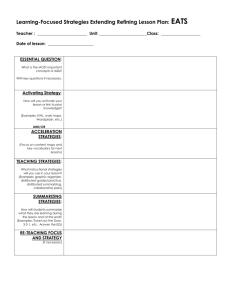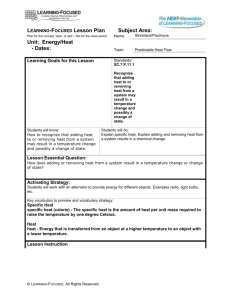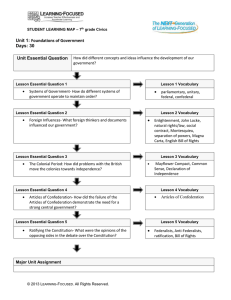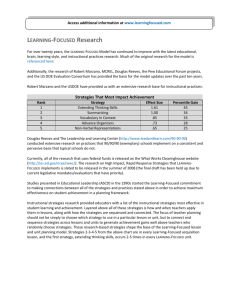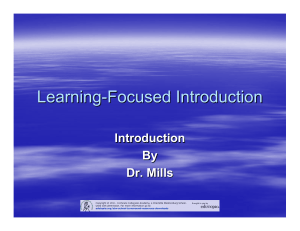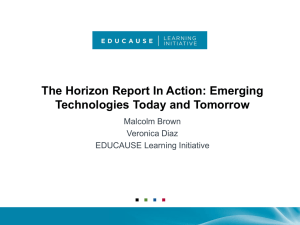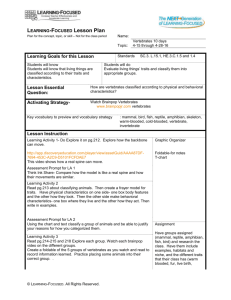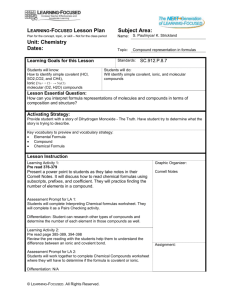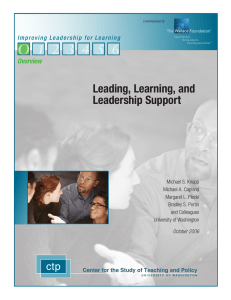1 2 3 4 5 6 O Leading, Learning, and Leadership Support
advertisement
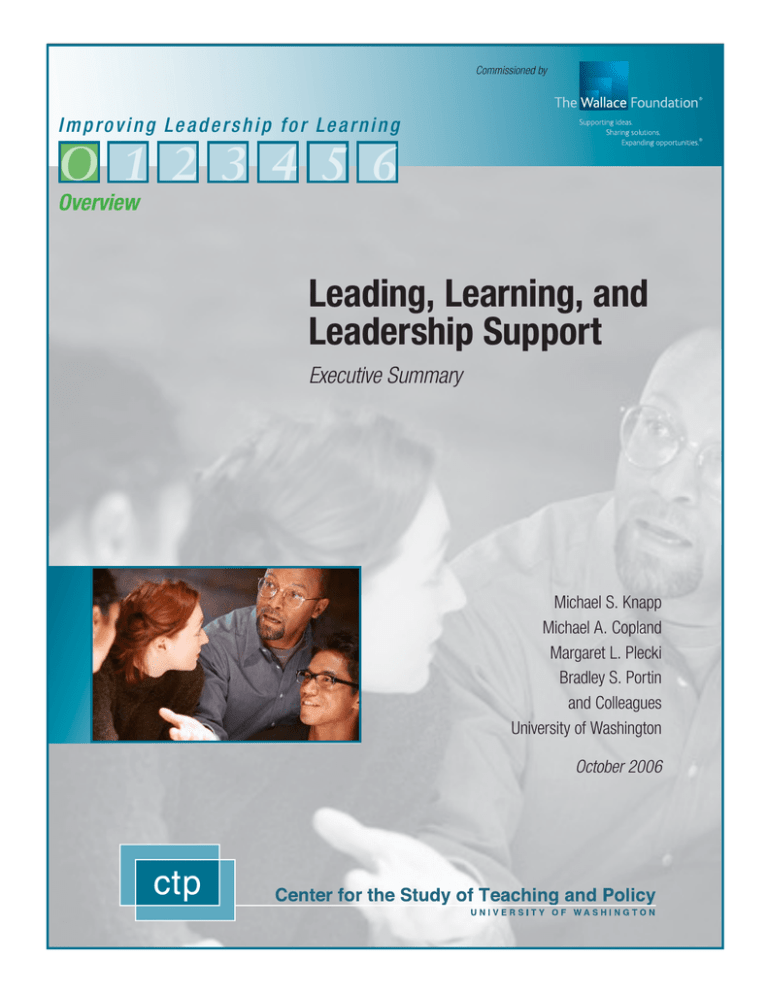
Commissioned by Impoving Leadership for Learning I m p r o v i n g Le a d e r s h i p f o r Le a r n i n g O 1 2 3 4 5 6 Overview Leading, Learning, and Leadership Support Executive Summary Michael S. Knapp Michael A. Copland Margaret L. Plecki Bradley S. Portin and Colleagues University of Washington October 2006 The Leadership Issue Project State-of-the-Field Reports: Improving Leadership for Learning These reports have been produced by a research team at the Center for the Study of Teaching and Policy, a national research consortium home-based at the University of Washington. Developed with support from The Wallace Foundation during the early stages of an initiative that explores central issues in the exercise of educational leadership, the reports synthesize studies, conceptual work, and examples of current and emerging practice. The reports are intended to clarify each leadership issue, while assembling what is known from empirical studies. The information in these reports lays the groundwork for further study and practical experimentation by leaders and reformers in states, districts, and schools. The first report offers an overview of leadership and leadership support in relation to the overarching goal of improving learning. The remaining six explore in more detail particular issues within that terrain. O 1 2 3 4 5 6 Overview Leading, Learning, and Leadership Support By Michael S. Knapp, Bradley S. Portin, Michael A. Copland, and Margaret L. Plecki. Data-Informed Leadership Data-Informed Leadership in Education By Michael S. Knapp, Juli Ann Swinnerton, Michael A. Copland, and Jack Monpas-Huber Resource Allocation Allocating Resources and Creating Incentives to Improve Teaching and Learning By Margaret L. Plecki, Christopher R. Alejano, Michael S. Knapp, and Chad Lochmiller Redefining Leadership Roles Redefining Roles, Responsibilities, and Authority of School Leaders By Bradley S. Portin, Christopher R. Alejano, Michael S. Knapp, and Elizabeth Marzolf Leadership Assessment Purposes, Uses, and Practices of Leadership Assessment in Education By Bradley S. Portin, Sue Feldman, and Michael S. Knapp Improving Governance Redefining and Improving School District Governance By Margaret L. Plecki, Julie McCleery, and Michael S. Knapp High School Transformation Leadership for Transforming High Schools By Michael A. Copland and Elizabeth Boatright These documents can be downloaded free of charge from the Center’s Web site, www.ctpweb.org, and also from The Wallace Foundation’s Knowledge Center site, www.wallacefoundation.org. The development of these reports was supported by a grant from The Wallace Foundation. Opinions represent those of the authors and not necessarily those of the Foundation. Leading, Learning, and Leadership Support Executive Summary Michael S. Knapp Michael A. Copland Margaret L. Plecki Bradley S. Portin and Colleagues University of Washington October 2006 Summary: Leading, Learning, and Leadership Support It is a difficult, yet exciting, time to practice. How do they create condibe an educational leader. So much is tions that prompt and enable leaders expected of school leaders, district to constructively influence learning officials, school board members, or outcomes? even teachers who are assuming forThis report summary, and the mal or informal leadership responlonger report of which it is a part, sibilities. State educational leaders offer answers to these questions. operating at some distance from the We do so by mapping out, in broad classroom face the same high expec- strokes, the leadership activities and tations, along with the demands of supporting conditions that enable guiding an entire educational system learning-focused leadership to haptoward improved performance. The pen, while suggesting entry points climate of high accountability under- whereby leaders who wish to pursue scores the weight of the expectations learning improvement agendas may facing all these leaders. The stakes do so. The report accompanies a are high. series of six others that delve more The biggest challenge lies in deeply into particular dimensions of visualizing how to connect leaderthis broad territory. ship practice with student learning, The report rests on scholarship and then mobilizing others’ enerand practical experimentation that gies and commitment accordingly. reflect an emerging understanding of This challenge implicates not only the kinds of leadership and leaderindividual leaders, operating from ship support which meet this chaltheir respective vantage points in a lenge. This view presumes that more complicated system, but all of them than student learning is involved. together. How are they to bring Active learning on the part of teachtheir collective efforts to bear on ers and administrators and on the the task of improving learning for part of the system as a whole can all students? And it also implicates reinforce the process and outcomes a larger cast of characters whose of improving student learning. In actions guide or support leadership schools certain kinds of leadership L e a di ng, L e a r n i ng, a n d L e a de rsh ip Su pport action are likely to enhance the pros- Activities and Conditions that Prompt and pects for learning improvement, and Support Learning-Focused Leadership evidence is emerging that compaA productive way to think about this rable leadership actions at the school challenge highlights three layers of district level can make a difference activity that prompt and support in learning outcomes. But the fine leaders’ efforts to improve the learndetail of learning-focused leadership ing in public schools. First, some of action and the corresponding leader- these activities are embedded in the ship support systems have yet to be exercise of leadership itself, a second described and studied in ways that layer seeks to guide or support leadinform practice. This report begins ership practice, while a third layer to address that need. sets broader policies not targeted Figure S-1. Activities and Conditions that Shape Learning-Focused Leadership Policy Environments: Federal-state-local activities that affect resources, set reform expectations, and allocate authority Leadership Support System State-local activities that seek to direct, support, improve, and assess leadership practice The Exercise of Learning-Focused Leadership What leaders bring to— and learn from— their work Leadership practice Feedback on learning, improvement efforts, and performance I m p rov i n g L e a d e r s h i p f o r L e a r n i n g Potential leadership influences on student, professional, and system learning to leadership per se, yet which can powerfully affect leadership practice. Separately and together, these activities create conditions that shape and support what leaders do, think to do, and are able to do, in relation to learning improvement, schematically suggested in Figure S-1. The starting point is leaders’ persistent and public commitment to focus the school, district, or state educational system on the quality of learning for all students. At first glance, standards-based reform policies may appear to do just that, but interpreted too literally, these reforms can easily push educators to become preoccupied with achievement score measures, rather than with a broader concept of learning and learning improvement. Caught up in a compliance mentality, educators can easily lose sight of the professional learning and “system learning” that sustainable learning improvement under standards-based reform implies. Activities embedded in the exercise of leadership itself. Given the intent to exercise learningfocused leadership, particular kinds of activities are implicated in any learning improvement strategy— • R edefining leadership roles and responsibilities. School and district leaders reconstruct or assume redesigned leadership roles that keep matters of learning improvement in the foreground as a central, collective responsibility. • U sing data, evidence, and feedback. Leaders at all levels generate, access, and use information that helps them pinpoint learning needs, imagine solutions, describe the operation of programs, and assess performance. Of particular importance are various forms of feedback to leaders concerning their own and others’ efforts to address learning agendas. • F ocusing resources on learning. Local and state leaders allocate—which often means reallocating—resources that directly support the learning of students, teachers, and others, while managing the politics of (re)allocation accordingly. In addition, rather than treating resources as fixed quantities, they pay particular attention to developing resources, especially the human resources—the teaching staff and instructional support personnel who are in a position to serve the full range of students’ learning needs. L e a di ng, L e a r n i ng, a n d L e a de rsh ip Su pport Activities that seek to guide or support leadership practice. One step removed, other activities at the state and local level take aim at the way leaders think about and approach their work, thereby guiding or supporting leaders toward more learning-focused forms of practice, by— • D eveloping future leadership capacity. As part of formal preparation programs, recruitment initiatives, or “homegrown” leadership development arrangements inside school districts, a new generation of teacher leaders, school administrators, district officials, instructional improvement coaches, or an agency’s leadership cadre can be identified and nurtured, who take learning improvement seriously and understand what it means. • P roviding direction or models for leaders’ daily work. Certain state and local policies and practices communicate what is expected for leaders’ work— e.g., through widely promulgated leadership standards, specifications for leadership positions, and arrangements for administrator supervision. Though they often don’t, these I m p rov i n g L e a d e r s h i p f o r L e a r n i n g communications about leaders’ work can speak clearly and forcefully about learning-focused leadership practice. • S upporting the ongoing professional learning of practicing leaders. Arrangements of many kinds, from individual mentoring or coaching to formal professional development sessions, teach individuals or leadership teams what it might mean to focus energy more centrally on learning improvement. • E stablishing leadership assessment systems. Arrangements for generating evaluative data about leadership performance, either as formative guidance for the leaders’ growth or summative judgments about their accomplishments and capacity, can generate data about the learning-focused aspects of leaders’ practice. Activities that set broader policies not targeted to leadership per se, yet which powerfully affect leadership practice. Finally, other activities in federal, state, and local policy environments address facets of the educational system that have important implications for leaders’ work, even though they are not pri- marily aimed at leadership practice. These activities occur in— • T he authorizing environment, generated by governance arrangements (at all levels), collective bargaining and the contractual agreements it produces, and the interaction among educational stakeholders within and around these arrangements. that produces these policies. At a minimum, participants can look hard at what these policies might mean for leaders’ ability to focus their energies on learning improvement; at best, participants in policy environments can coalesce around actions that will make leaders’ jobs easier. What It Looks Like in Practice These broad categories of activity beg questions about what people or • T he resource environment, groups located in different positions including the sources of funds within states, districts, or schools and human resources, and also actually do in attempting to guide the infrastructure for gatheror support leadership practice that ing information on and for focuses on learning improvement. the schools, as well as rules Some examples, developed further in governing the use of these the full report and the accompanyresources. ing six reports, follow. In schools, a relatively small • T he reform policy environment, number of educators are implicated comprising the forces and conditions created by state and in the leadership of the school, but more than the formal administrators federal policies aimed at en(principal, assistant principal) may hancing the quality of schoolparticipate in activities that broaden ing, such as standards-based the concept of “leadership” and reform policies. focus it on matters of teaching and In numerous ways, these learning in classrooms, as illustrated actions in the policy environments by the activities in Table 1. invite or command the attention of educational leaders. While the particular policies that come to the fore reflect many interests, a concern for the quality of learning may be infused into the debate and interplay L e a di ng, L e a r n i ng, a n d L e a de rsh ip Su pport Table 1. Illustrative Activities at the School Level that Prompt or Support Learning-focused Leadership Embedded in the exercise of learningfocused leadership itself • Role redefinition: Establishing teams within the school which take on instructional leadership responsibilities • Information use: Setting up systems for teachers to examine student work in relation to grade-level expectations and state standards • Resource reallocation: Reallocating time so that teachers can work together on instructional planning Aimed at guiding or supporting leadership practice • Leadership development: Identifying teachers with leadership potential and nurturing their growth as a future instructional leadership cadre • Direction for leaders’ daily work: Adopting school-specific statements about what is expected of all who exercise leadership • Support for leaders’ professional learning: Creating regular occasions for leaders in the school to engage in new learning about high-quality teaching • Leadership assessment systems: Developing a 360-system for gaining regular feedback on the principal’s and other leaders’ effectiveness Table 2. Illustrative Activities at the District Level that Prompt or Support Learning-focused Leadership Embedded in the exercise of learningfocused leadership itself • Role redefinition: Creating managerial support roles to remove some aspects of the routine work of the principalship and enable more of a learning focus • Information use: Creating or locating informational tools for school leaders • Resource reallocation: Making teacher professional development, linked to identified learning agendas, a resource priority I m p rov i n g L e a d e r s h i p f o r L e a r n i n g Aimed at guiding or supporting leadership practice • Leadership development: Developing a “leadership pipeline” strategy for the district, in conjunction with a local provider, that seeks to “grow” personnel through various stages of leadership careers • Direction for leaders’ daily work: Adapting state leadership standards in ways that reflect local learning improvement priorities • Support for leaders’ professional learning: Creating a local leadership induction/mentoring program, parallel to teacher induction and mentoring • Leadership assessment systems: Creating learning-focused criteria to guide leadership assessment within the district At the district level, a differground is hard, or even impossible, ent set of individuals come into play, to find. Yet separately and, when who occupy positions that are gener- possible, together, these players have ally defined in terms of administrathe capacity to make a focus on tive functions—personnel, budget, learning and the ramifications for transportation, community relaleadership support central to their tions, school administrator supervirespective contributions to the mix sion, and so on—only some of which of policies aimed at schools, as are formally related to teaching and Table 3 suggests. learning. Left to their own devices, Not shown in any one of these their work will often have little to tables is the potentially reinforcing do with learning improvement, but effect that activities in one area and through intentional action by leadat one level of the system can have on ers strategically placed within the each other. The enduring challenge central office—often the superinten- is one of finding coherent, sustaindent and administrative cabinet, but able ways to join forces across jurisother mid-level staff as well—district dictional or positional boundaries, central offices can develop new ways and across levels in the system, in the of relating to schools, implied by service of learning-focused leadership the activities shown in Table 2, that and leadership support. concentrate effort and attention on learning improvement goals. A more dispersed set of actors participate in the state policy environments that affect local educational leaders’ work. The organizational and political cleavages between State Education Department, governor’s office, legislature (both houses), State Board of Education, and other players (e.g., professional Standards Board) will often mean that common L e a di ng, L e a r n i ng, a n d L e a de rsh ip Su pport Table 3. Illustrative Activities in the State Policy Environment that Affect Leaders’ Ability to Focus on Learning Improvement Aimed at guiding or supporting leadership practice • Leadership development: Ensuring that principal licensure standards are keyed to learning improvement goals • Direction for leaders’ daily work: Publicly promoting instructional leadership and related aspects of learning-focused leadership as a central responsibility of local educational leaders • Support for leaders’ professional learning: Investing state dollars in periodic professional development for practicing leaders (e.g., to promote instructional leadership), especially for school leaders in their first three years • Leadership assessment systems: Linking leadership assessment to explicit, learningfocused standards for leadership practice Entry Points Emerging practices and some more established ones, in educational systems that show signs of improvement (at least, as indicated by test score performance), suggest the following six entry points in the process of nudging educational systems toward a greater and better supported focus on learning improvement: 1. E stablishing a clear and public focus on learning improvement priorities for students, professionals, and the system as a whole. Here, leaders are in a position to put all of these learning agendas on the table I m p rov i n g L e a d e r s h i p f o r L e a r n i n g Aimed at broader policy, not specific to leadership, yet with major implications for learning-focused practice • Authorizing environment: State governing bodies creating occasions for cross-department conversation about learning goals • Resource environment: Creating incentives that encourage the relocation of staff to better serve unmet student needs • Reform policy environment: Allowing districts flexibility in defining the indicators of success in achieving state standards-based reform goals and to encourage action that creates mutual reinforcement among them. 2. Reconceiving leadership roles so that they emphasize learning improvement, take full advantage of the collective capacity of staff, and still manage basic operational needs of schools and districts. Here, working together, district and school staff have numerous ways to distribute responsibility for important tasks such as instructional leadership. They can do so differently at elementary, middle, and high school levels, if attention is paid to the level-specific meaning of these leadership roles. 3. I nforming leadership action with data and inquiry that relates to learning needs, performance, and conditions supporting learning. Here, state and local leaders can do much more to prompt “cycles of inquiry” in schools, district central offices, and state agencies and as they do so encourage “cultures of inquiry” in these settings. Building robust data infrastructures and investing in efforts to help leaders develop “data literacy,” broadly construed, will help support these cycles of inquiry. 4. Aligning people, money, and time as closely as possible with learning improvement priorities. Because funds, staff, and time do not always bear a close relation to learning improvement priorities, there are many opportunities to bring them more into line, though doing so will often generate active political resistance or simply have to work against the weight of tradi- tional practice. Reallocating funds and staffing incentives to support high-needs schools is especially important, as is the configuration of time that will support joint planning and professional learning. 5. Providing leaders with regular feedback about their work in relation to learning improvement priorities, combined with regular opportunities to learn about and from their work. In a much more fine-grained way than annual assessments of student learning provide, leaders in a variety of school and district positions can benefit from assessment feedback, both formal and informal, that helps them know how to improve their practice. The goal of improving leadership practice is more likely to be achieved when the feedback is tied to opportunities for further professional learning in the context of daily work (e.g., through mentoring systems). 6. C ombining clear guidance for leaders with sufficient room to exercise discretion over matters related to learning improvement. State and local L e a di ng, L e a r n i ng, a n d L e a de rsh ip Su pport governing bodies and others unrealistic expectations on educawho define what educational tional leaders, as if they were solely leaders are expected to do responsible for the learning of the have substantial opportunities nation’s young people. And we also to communicate more expliccaution that partial solutions—that itly the centrality of learning attend to one kind of supportive conimprovement in leaders’ work. dition while ignoring another—may But the message needs to be set the stage for leaders and the eduaccompanied by attention cators they lead to fail. Information to the degree of discretion without resources, new roles without leaders need to carry out this authority to act, learning-focused responsibility. leadership activity without feedback on it—all may fall short of the These entry points are only promise that lies in the attempt to illustrative, and they are not based renew and refocus leadership pracon a complete and irrefutable evitice in education. dence base about the development and ultimate effectiveness of learning-focused practice. There is much we have yet to learn about how to encourage and support these leadership practices, yet the logic is clear and compelling, and emerging evidence and images of possibility suggest that the logic is sound. We close with a hope and a caution. The hope is that these ideas prompt further efforts to connect different leaders’ efforts with one another, especially across levels in the system, in pursuit of a more coherent web of support for strong, learning-focused leadership in schools and school districts. The caution is that we avoid placing 10 I m p rov i n g L e a d e r s h i p f o r L e a r n i n g CTP—a national research consortium home-based at the University of Washington and including three other research partners (Stanford, University of Pennsylvania, and University of Michigan)—studies the way policies, leadership, and conditions in schools, districts, states, the federal government, and the education profession shape the quality of teaching and learning in the nation’s schools. The Center pays particular attention to the ways these forces and conditions interact with each other to influence what teachers, learners, and educational leaders do in daily practice. A major goal of the Center’s program of research is to discover and document the means for improving practice so that the nation’s young people experience a challenging and equitable education. To that end, the Center’s research products are designed to inform policymakers, practicing leaders, and the educational reform community, along with scholars. The Wallace Foundation seeks to support and share effective ideas and practices that expand learning and enrichment opportunities for all people. Its three current objectives are: • Strengthen education leadership to improve student achievement • Enhance out-of-school learning opportunities • Expand participation in arts and culture For more information and research on these and other related topics, please visit our Knowledge Center at www.wallacefoundation.org. KSA-Plus Communications: design and editorial Commissioned by Miller Hall 404, College of Education • University of Washington • Box 353600 • Seattle, WA 98195-3600 Phone: (206) 221-4114 • Fax: (206) 616-8158 • Email: ctpmail@u.washington.edu
